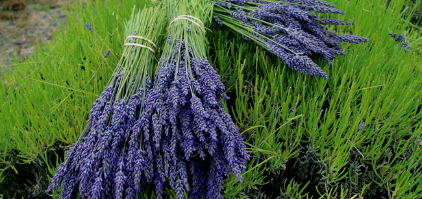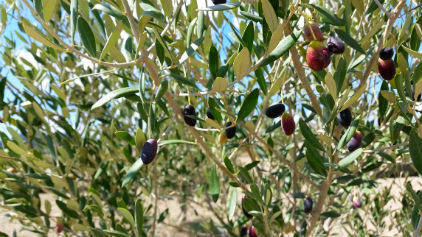
tel. 512 280 1192 April 19, 2018
Nursery notes: unique and interesting specimens are filling the
greenhouses this week. Patchouli, scented geraniums (nutmeg and
lemon), datura - white, double yellow and double purple - Viet-
namese coriander, honeydew melons, lace-leaf lavender, elder-
berry, goji berries, Mexican oregano and Mexican mint marigold.
Happy earth day! Please drop by for a visit ; - ) ❦

A Guide to Lavender: make your Lavandula happy with sun,
warmth and well-drained soil, and help them avoid cold, fog, wet
roots, snow and ice. Advice from Michelle Slatalla on the likes and
dislikes of jagged, gray and silver French, white and Spanish variet-
ies. Gardenista ❦
____________________________________________________
The Lazy Gardener: an interesting class at the Wildflower Cen-
ter this Saturday from 1 - 4 p.m. promises to 'take the “work” out
of yard work and unearth your inner green thumb as a pro gardener
arms you with the basics of native plant caretaking.' $30 for non-
members. The Lazy Gardener ❦
____________________________________________________
Central Texas Gardener: Learn from Tim Kiphart how to create
structural drama in your backyard with succulents, clumping bam-
boo and flowering perennials. On tour, two east Austin gardeners
applied geometry in front to boost dimension on their small lot in
east Austin. Saturday 4 p.m. Sunday 9 a.m. KLRU ❦

Olives are my Mission
by Amanda Moon
Every garden should have an olive tree. They are so beautiful…
the way their narrow gray foliage dances in the wind – and, they’re
perfectly suited to our hot and dry climate. Olives are hardy, drought-
resistant evergreens, and are as easy to grow as crepe myrtles.
They have been in this country for hundreds of years, from Georgia
to California (and in between in Texas of course). Originally hail-
ing from the Mediterranean regions of Europe, they were brought
over to the US by monks stationed at the Spanish missions through-
out the southern part of our country.
However they fell out of favor for a while due to cheaper crops and
loss of labor from the many battles fought on our soil in the 1700-
1800s. But in the early 20th century olives were planted again in
south Texas.
These are still thriving along with other olive farms that have popp-
ed up all over south and south central Texas. Many are now selling
their olive oil at local farmers markets including the original Texas
Olive Ranch, as well as Central Texas Olive Ranch in Georgetown.
Mission is the original olive tree grown in this country and it is
thought of as an American olive. It is a hardy olive tree for much
of Texas with a relatively quick growth rate. This variety takes
some time to set fruit, but is considered by most to be self-pollin-
ating.
It is used both as a table olive and pressed for oil. Other oil varie-
ties that do well here and produce earlier (if fruit is your objective)
are Arbequina, Arbosana, and Koroneiki - which helps pollinate
the other two.
The Missions typically grow to a height of 15’-20’, while the other
varieties tend to stay smaller. They prefer full sun and excellent
drainage. It is best if you can plant the tree in a south facing loc-
ation as they can be knocked back in extreme winter temperatures.
In 2010 the Mission at It’s About Thyme froze back a little with
an extended period of below freezing temps, but popped right back
out when the weather warmed up. The low teens the year before
that did not faze it at all. Aside from the occasional die-back they’re
evergreen most years.
If you like the look of an olive but don’t have much room or desire
for fruit you have to do something with, then an option is a dwarf
variety called Little Ollie. It is grown as a 3’ shrub instead of a tree
so would be a great addition to a smaller bed.
Olives are great xeric specimen trees that require little follow up
care once established and do not suffer from many pests. The bigg-
est problem I have had on mine (and they are still low to the ground
in pots) has been from leaf-chewing insects.
Because they are usually evergreen and grow relatively fast they’re
very effective as a quick growing screen along fence lines or to
block your neighbor's second story windows.
Just driving around I am now seeing olive trees in so many land-
scapes, parks and backyards – and it is so good to see that olives
have earned their place (once again) in Texas landscapes. Happy
gardening everyone!❦
(Mission and arbequina olive trees in stock: 5 gal: $50, 15 gal
$150 Mexican wild olives: 5 gal $50, 15 gal $125.)


